Choosing a Gaming CPU October 2013: i7-4960X, i5-4670K, Nehalem and Intel Update
by Ian Cutress on October 3, 2013 10:05 AM ESTCPU Benchmarks
Point Calculations - 3D Movement Algorithm Test
The algorithms in 3DPM employ both uniform random number generation or normal distribution random number generation, and vary in various amounts of trigonometric operations, conditional statements, generation and rejection, fused operations, etc. The benchmark runs through six algorithms for a specified number of particles and steps, and calculates the speed of each algorithm, then sums them all for a final score. This is an example of a real world situation that a computational scientist may find themselves in, rather than a pure synthetic benchmark. The benchmark is also parallel between particles simulated, and we test the single thread performance as well as the multi-threaded performance.

For single thread performance, the higher MHz Haswell CPUs sit on top of the list - interestingly enough it is the Xeons. Comparing these to the i7-4960X, which also sits at 4 GHz, shows the generational difference in this purely multithreaded test. The 100 MHz difference between the i5-4670K and the i7-4770K shows up as two points in this test. The s1366 CPUs are staggered between a score of 90.93 and 115.79, with the i7-920 falling short of the X6-1100T. Due to the IPC difference the i7-990X is behind the i5-2500K and anything older at a similar MHz.
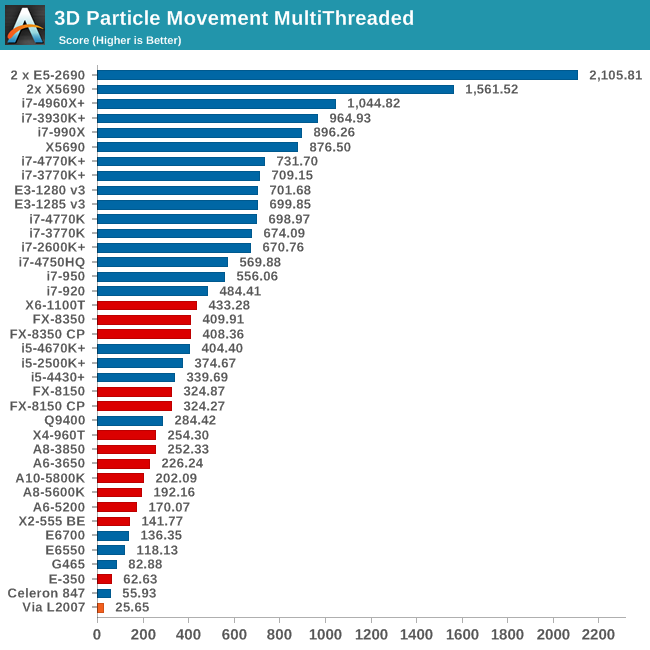
For the multithreaded test, cores and MHz with FP performance win out here, so the i5-4670K, even in a motherboard with Multi-Core Turbo, sits behind the eight threads of the FX-8350 and six threads of the X6-1100T. The i7-4770K scores another 75%, along with the Xeons. In terms of the Nehalem CPUs, the i7-990X performs an extra 200 points higher than the latest Haswell CPUs due to its six core / twelve thread design. Unfortunately the i7-920/i7-950 are a little behind, with the i7-2600K offering a noticable boost.
Compression - WinRAR x64 3.93 + WinRAR 4.2
With 64-bit WinRAR, we compress the set of files used in the USB speed tests. WinRAR x64 3.93 attempts to use multithreading when possible, and provides as a good test for when a system has variable threaded load. WinRAR 4.2 does this a lot better! If a system has multiple speeds to invoke at different loading, the switching between those speeds will determine how well the system will do.
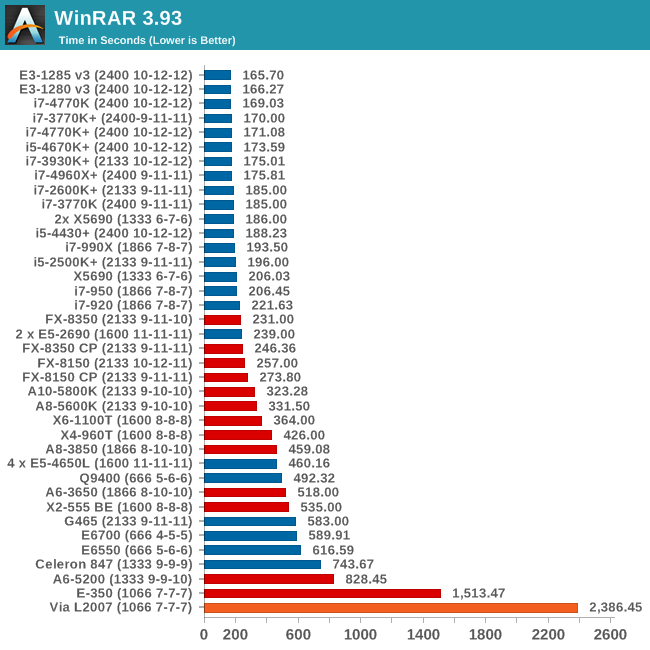
The only downside with WinRAR is that when you're dealing with slow CPUs, they are very slow! The quad core Nehalem CPUs are kept on track by the FX-8350 using this older version of WinRAR, although it seems the higher IPC wins out here over cores with the 4.0 GHz Haswell Xeons scoring best.
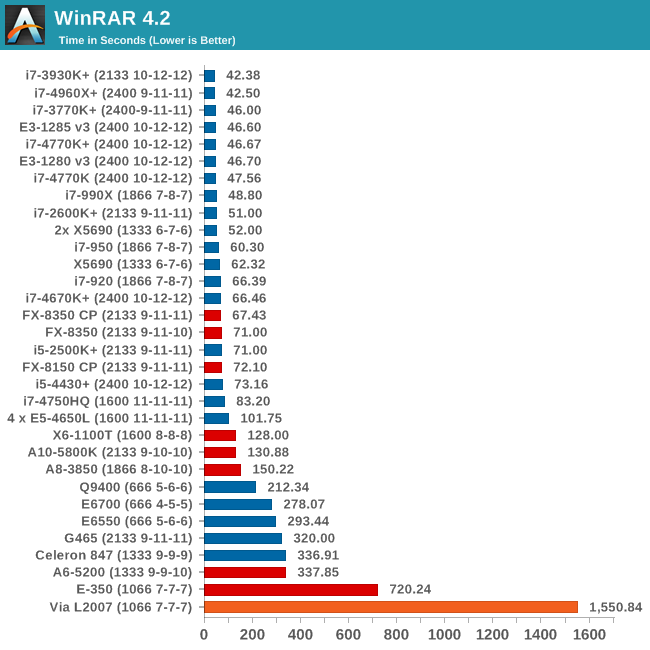
The improvements in WinRAR 4.2 due to optimisations and multi-threading result in more cores giving better results. The i7-990X does well here, although Sandy Bridge-E and Ivy Bridge-E take the top spots. Due to the threading advantage WinRAR takes, the i7-4770K gets a 20 second advantage of its non-hyperthreaded cousin, the i5-4670K.
Image Manipulation - FastStone Image Viewer 4.2
FastStone Image Viewer is a free piece of software I have been using for quite a few years now. It allows quick viewing of flat images, as well as resizing, changing color depth, adding simple text or simple filters. It also has a bulk image conversion tool, which we use here. The software currently operates only in single-thread mode, which should change in later versions of the software. For this test, we convert a series of 170 files, of various resolutions, dimensions and types (of a total size of 163MB), all to the .gif format of 640x480 dimensions.
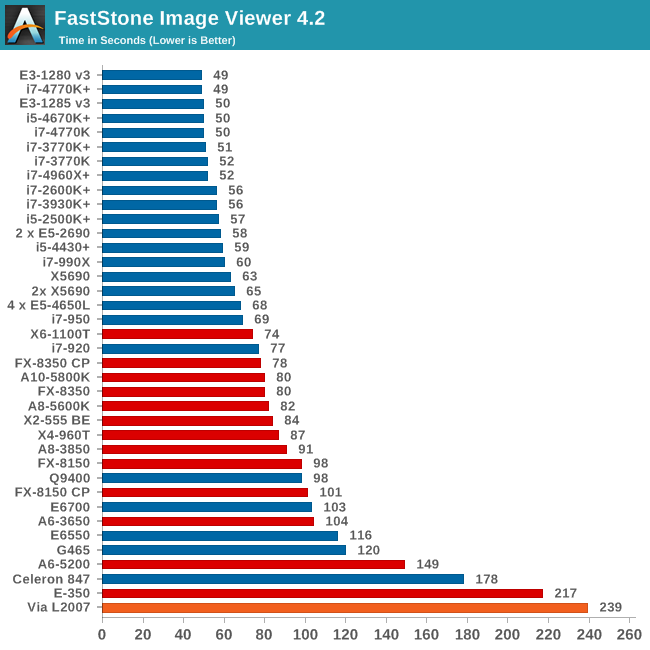
FastStone loves single threaded IPC and MHz, so it's no surprise for the Haswell CPUs to be on top, with no discernable difference between the i5-4670K and the i7-4770K. The old school Nehalems take a knock, with the i7-920 being almost a full 60% slower than the top scores.
Video Conversion - Xilisoft Video Converter 7
With XVC, users can convert any type of normal video to any compatible format for smartphones, tablets and other devices. By default, it uses all available threads on the system, and in the presence of appropriate graphics cards, can utilize CUDA for NVIDIA GPUs as well as AMD WinAPP for AMD GPUs. For this test, we use a set of 33 HD videos, each lasting 30 seconds, and convert them from 1080p to an iPod H.264 video format using just the CPU. The time taken to convert these videos gives us our result.
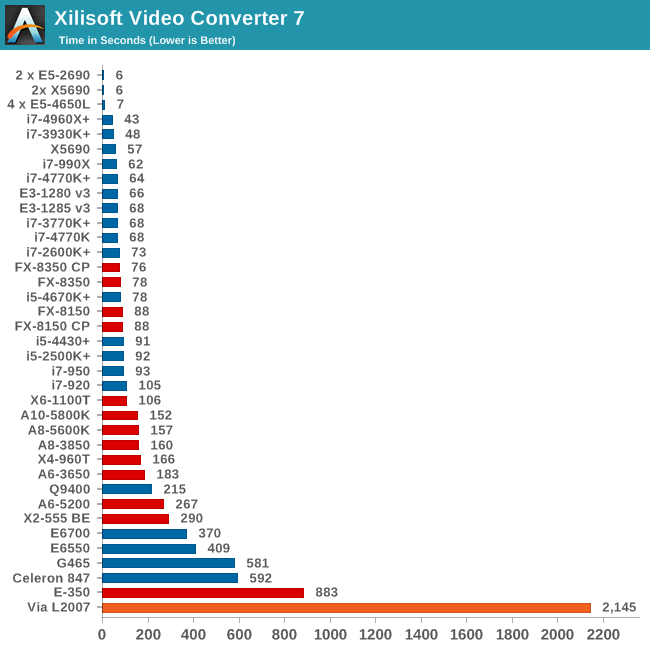
For fully multithreaded video conversion, a combination of cores, IPC and MHz take top spots, hence the i7-4960X is the consumer CPU to get. The i7-990X has a smaller advantage over the quad core Haswells this time, and here is one benchmark where the i5-4670K falls behind the FX-8350s due to the integer nature of the workload. Interestingly enough the i5-4430 slots in with an i5-2500K due to IPC increases despite lower power consumption and MHz.
Rendering – PovRay 3.7
The Persistence of Vision RayTracer, or PovRay, is a freeware package for as the name suggests, ray tracing. It is a pure renderer, rather than modeling software, but the latest beta version contains a handy benchmark for stressing all processing threads on a platform. We have been using this test in motherboard reviews to test memory stability at various CPU speeds to good effect – if it passes the test, the IMC in the CPU is stable for a given CPU speed. As a CPU test, it runs for approximately 2-3 minutes on high end platforms.

PovRay is another 'multithreading takes all', as shown by our 4P testing on E5-4650L CPUs. The i7-990X still shows its worth, being as quick as the i7-4770K at least, although the i7-920 and i7-950 are further down the pecking order.
Video Conversion - x264 HD Benchmark
The x264 HD Benchmark uses a common HD encoding tool to process an HD MPEG2 source at 1280x720 at 3963 Kbps. This test represents a standardized result which can be compared across other reviews, and is dependent on both CPU power and memory speed. The benchmark performs a 2-pass encode, and the results shown are the average of each pass performed four times.
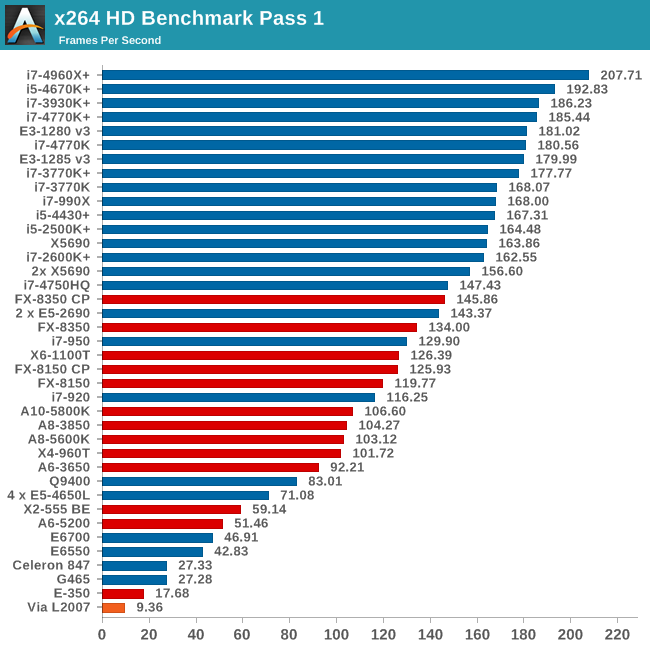
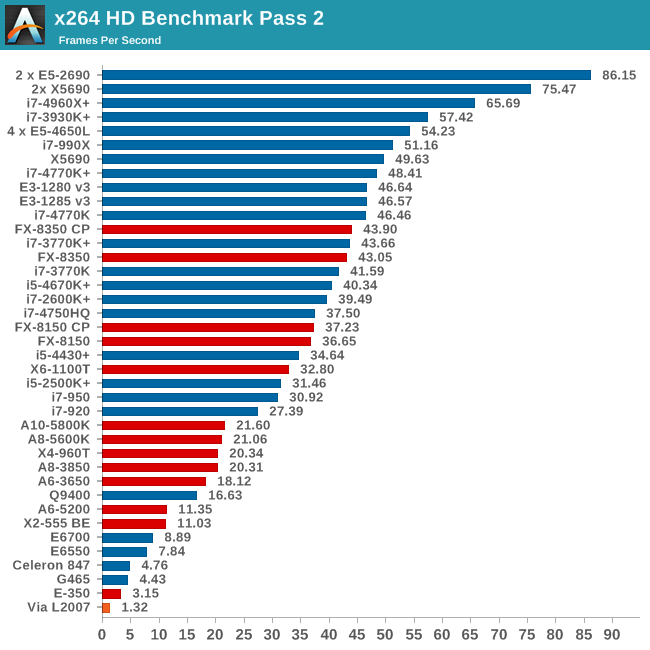
Grid Solvers - Explicit Finite Difference
For any grid of regular nodes, the simplest way to calculate the next time step is to use the values of those around it. This makes for easy mathematics and parallel simulation, as each node calculated is only dependent on the previous time step, not the nodes around it on the current calculated time step. By choosing a regular grid, we reduce the levels of memory access required for irregular grids. We test both 2D and 3D explicit finite difference simulations with 2n nodes in each dimension, using OpenMP as the threading operator in single precision. The grid is isotropic and the boundary conditions are sinks. Values are floating point, with memory cache sizes and speeds playing a part in the overall score.


Grid solvers do love a fast processor and plenty of cache in order to store data. When moving up to 3D, it is harder to keep that data within the CPU and spending extra time coding in batches can help throughput. Our simulation takes a very naïve approach in code, using simple operations, but that doesn't stop the single socket, highly threaded CPUs taking top spots. The i5-4670K takes a surprising twist in 2D, outpacing the i7-4770K.
Grid Solvers - Implicit Finite Difference + Alternating Direction Implicit Method
The implicit method takes a different approach to the explicit method – instead of considering one unknown in the new time step to be calculated from known elements in the previous time step, we consider that an old point can influence several new points by way of simultaneous equations. This adds to the complexity of the simulation – the grid of nodes is solved as a series of rows and columns rather than points, reducing the parallel nature of the simulation by a dimension and drastically increasing the memory requirements of each thread. The upside, as noted above, is the less stringent stability rules related to time steps and grid spacing. For this we simulate a 2D grid of 2n nodes in each dimension, using OpenMP in single precision. Again our grid is isotropic with the boundaries acting as sinks. Values are floating point, with memory cache sizes and speeds playing a part in the overall score.

If anything, large caches matter more in implicit simulation, in line with both cores and threads. The i5-4430 is on the lower rungs of the Intel bloc, but the 990X is at the top.
Point Calculations - n-Body Simulation
When a series of heavy mass elements are in space, they interact with each other through the force of gravity. Thus when a star cluster forms, the interaction of every large mass with every other large mass defines the speed at which these elements approach each other. When dealing with millions and billions of stars on such a large scale, the movement of each of these stars can be simulated through the physical theorems that describe the interactions. The benchmark detects whether the processor is SSE2 or SSE4 capable, and implements the relative code. We run a simulation of 10240 particles of equal mass - the output for this code is in terms of GFLOPs, and the result recorded was the peak GFLOPs value.

Due to extension enhancements, we see that a quad core Haswell Xeon scores roughly the same as the hex-core Nehalem, with the i5-4430 not far behind. If anything, the i7-920 and i7-950 take a nose dive here, and it's worth investing even in an i5-4430 for a 50% performance enhancement.










137 Comments
View All Comments
warezme - Thursday, October 3, 2013 - link
I to invested in the venerable (speak only in awe hushed whispers), i7 920 which I promptly overclocked to 3.6Ghz. This little jewel has been going strong for Goodness almost half a decade? and stable as a rock and I notice holding it's own very well even up against the latest and greatest. This is a testament to competition and engineering when competition in the CPU arena existed. I have long switched from dual GPU's to single but dual core cards on a single fat 16x pci-e bus even though my Evga X58SLI board supports higher. I'll ride the wave one more year and see what new gear crashes in next year. Hopefully a new Nvidia architecture that will inspire me to upgrade everything.Hrel - Thursday, October 3, 2013 - link
"our next update will focus solely on the AMD midrange."Please don't do that. PLEASE include at least 3 Intel CPU's for comparison. It doesn't matter if the FX8320 does well in benchmarks if for another $40 bucks I can get a i54670 that runs 50% faster. These are hypothetical numbers, obviously, but then Intel will be faster. By how much matters, once you factor in price and energy draw especially.
A5 - Thursday, October 3, 2013 - link
The old numbers will still be there for comparison. The next update is just *adding* more AMD data.just4U - Thursday, October 3, 2013 - link
It's hard making sense of AMD data in comparison to Intel. As near as I can tell their sitting at just beyond i7920 performance these days but /w all the new features. It gets confusing when you look at the X4 X6 older stuff though since some of that is actually faster... yet somehow only compares favorably to Intel's 9X Core2 stuff.just4U - Thursday, October 3, 2013 - link
Why 3? The i5 entry level 4430 beats out every AMD chip on the market in most instances. Adding in more simply confuses people and adds more fodder for fanboys to fight over.. and I think it taxes the patience of most of us that already know what's what in the cpu arena.Simple rule of thumb. If your on a budget you may want to go AMD to get all the "other" bells and whistles your looking to buy or.. if you have a more to spend your starting point will be the i54430.
just4U - Thursday, October 3, 2013 - link
Excellent article Ian, I really like the inclusion of older CPU's. It's a good basis in which to decide if it's "time" to upgrade on that front. Most of the people I know are not on the bleeding edge of technology. Many sit back in 2009 with minor updates to video and Hard Drives. Anyway.. Well done lots to sift thru.Jackie60 - Thursday, October 3, 2013 - link
At last Anandtech is doing some meaningful second decade of 21st century testing. Well done and keep it up ffs!SolMiester - Thursday, October 3, 2013 - link
Can someone please tell me why we are using 2+ yr old GPUs?A5 - Thursday, October 3, 2013 - link
You could read the article.OrphanageExplosion - Thursday, October 3, 2013 - link
Amazing data. I do wonder whether the testing at max settings is a good idea though. The variation in performance can be extreme. Just watch the Metro 2033 benchmark play out. Does that look like the kind of experience you'd want to play?Perhaps more importantly though, the arrival of next-gen console changes everything.
Did you see the news that Watch Dogs is x64 only? That's just the tip of the iceberg. Developers need to go wide to make the most out of six available Jaguar cores. Jobs-based scheduling over up to eight cores will become the norm rather than the exception. The gap between i5 vs. i7 will widen. AMD FX will suddenly become a lot more interesting.
In short order, I'd expect to see dual core CPUs and less capable quads start to look much less capable very quickly. i5 vs. i7 will see a much larger gulf in performance.
Check out the CPU data here for the Battlefield 4 beta:
http://gamegpu.ru/action-/-fps-/-tps/battlefield-4...
The dual cores are being maxed out, FX-8350 is up there with the 3930K (!)